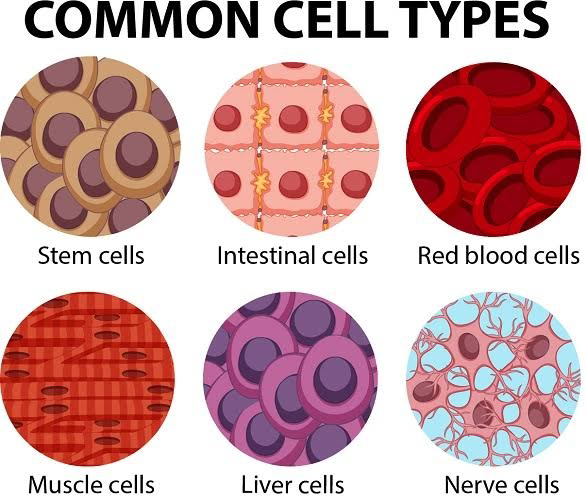Levels of Organization
Levels of organization
Remember, the human body is organization in several levels, from the simplest to the most complex...
1.Cells- the basic unit of life
2.Tissues - clusters of cells performing similar function
3.Organs - made of tissues that perform one specific function
4.Organ system- groups of organs that performs a specific purpose in the human body.
The purpose of the 11 organ systems
is for the human body to maintain homeostasis.
4- cell types
Muscle tissue :
Most abundant tissue, controls internal movement digestion, blood through veins external movement of body.
Epithelial tissue :
Covering for body and organs, lining of organs and vessels.
Connective tissue :
Holds organs in place ligaments, tendons, some keep organs in place
Nervous tissue :
Receives messages from body's internal and external messages analyze data and direct response.
The 11 human body systems
The 11 human body systems are as follows:
1.Nervous system --integumentary
system
2.Respiratory system --digestive system
3.Excretory system --skeletal system
4.Muscular system --circulatory system
5.Endocrine system --reproductive system
6.Lymphatic (immune) system
The circulatory system
Purpose:to deliver oxygenated blood to the various cella and organ systems in ur body so they can undergo cellular respiration.
Cell type - Muscle
Major organs and their functions
Heart - the major muscle of the circulatory system.
-pumps deoxygenated blood into the lungs, where it gets oxygenated, returned to the heart, and then pumped out through the aorta to the rest of the body
- valve regulate the flow of blood between the chambers
Organ system interactions
With lungs - exchange O2 and CO2
With digestive system - pick up nutrients for transport throughout the body
With excretory - blood is filtered to remove toxins and some water
Nervous system- heart beat regulation and blood pressure
Image of the circulatory system
The Nervous system
Purpose : to coordinate the body's response to changes in its internal and external environment.
Cell type - Nerve
Major organs and their functions
Brain -- contral center of the body, where all processes are relayed through
--consists of cerebrum (controls though and senses) and cerebellum
(Controls motor functions)
Spinal cord -- sends instructions from the brain to the rest of the body and vice versa
--any organism with a
major nerve cord is classified as a chordate
Nerves -- conduct impulses to muscle cells throughout the body
Nerves - neurons clustered into bundles of fibers(axon)
. 3 types :
1. Sensory --carry impulses from sense organs to brain and spinal cord.
2.Motor --from brain or spinal to other organs.
3.Interneuron--connects sensory and motor neurons.
Synapse- point at which a neuron can transfer an impulse to another cell.
Human Nervous System
1.Central Nervous System (CNS) - the control center.
A. Brain - 100billion ces neurons
a. Cerebrum - largest part, responsible for learning , intelligence, and judgment.
b. Cerebellum - Coordinates and balances actions of muscle. (Posture, movement, and balance.)
c. Brainstem- regulates blood pressure, heart rate, breathing, and swallowing. (Thalamus, hypothalamus, midbrain, pons, and medulla oblongata.)
Nerves- conduct impulses to muscle cells throughout the body.
Organ Systems Interactions
. Nervous system is interactive with all other systems in the body .
The Respiratory System
Purpose: to provide the body with a fresh supply of oxygen for cellular respiration and remove the waste product carbon dioxide.
Cell type : Epithilial
Major Organs and their Functions
1.None - internal entry and exist point for air
2.Pharynx- serves as a passage way for both air and food at the back of the throat
3.larynx - your "voice box ", as air passes your vocal chords, you speak
4.Trachea - the " Windpipe " , or what connects your pharynx to your lungs, a piece of skin, called the epiglottis, covers the trachea when you swallow , preventing food entering .
Bronchi
The two large passageways that lead from the trachea to ur lungs (one for each lung)
The bronchi are further subdivided into bronchioles
Eventually, the further subdivision lead to tiny air sacs called alveoli
Alveoli are in clusters, like grapes
Capillaries surrounding each alveolus is where the exchange of gases with the blood occurs.
Lungs
-- Contain the alveoli, bronchi and connective tissue .
The diaphragm is the muscle that causes you to breath, hiccups are involuntary contractions of the diaphragm.
WHY ARE ALVEOLI SO IMPORTANT?
Alveoli are the air sacs of the lungs.
They have thin walls made of simple cells and are surrounded by blood capillaries.
Gas exchange occurs in the alveoli.
-- oxygen gas is in higher concentration in the alveoli than in the blood through a layer of cells.
-- carbon dioxide is in higher concentration in tha blood than the alveoli and so it diffuses into the alveoli through a layer of cells.
The surface of alveoli are covered in a thin lipoprotein layer and it prevents them from collapsing during exhalation.
Organ System Interactions
The respiratory system directly interacts with the circulatory system
Indirectly interacts with the immune system (lining of the nasal and bronchiol cavities /tubes)
Nervous system (smell and taste) -regulation of breathing.
Image of the Respiratory System

Dr. Mahalakshmi Raghunath












Comments
Post a Comment